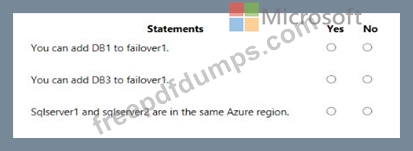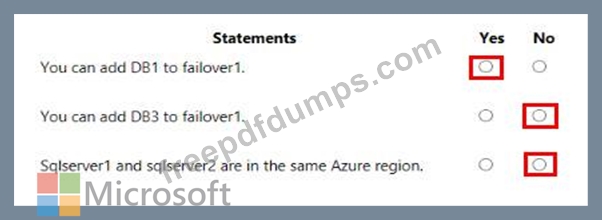AZ-303 Exam Question 36
A company hosts virtual machines (VMs) in an on-premises datacenter and in Azure. The on-premises and Azure-based VMs communicate using ExpressRoute.
The company wants to be able to continue regular operations if the ExpressRoute connection fails. Failover connections must use the Internet and must not require Multiprotocol Label Switching (MPLS) support.
You need to recommend a solution that provides continued operations.
What should you recommend?
The company wants to be able to continue regular operations if the ExpressRoute connection fails. Failover connections must use the Internet and must not require Multiprotocol Label Switching (MPLS) support.
You need to recommend a solution that provides continued operations.
What should you recommend?
AZ-303 Exam Question 37
You have an Azure subscription named Subscription1.
You create several Azure virtual machines in Subscription1. All of the virtual machines belong to the same virtual network.
You have an on-premises Hyper-V server named Server1. Server1 hosts a virtual machine named VM1.
You plan to replicate VM1 to Azure.
You need to create additional objects in Subscription1 to support the planned deployment.
Which three objects should you create? Each correct answer presents part of the solution.
NOTE: Each correct selection is worth one point.
You create several Azure virtual machines in Subscription1. All of the virtual machines belong to the same virtual network.
You have an on-premises Hyper-V server named Server1. Server1 hosts a virtual machine named VM1.
You plan to replicate VM1 to Azure.
You need to create additional objects in Subscription1 to support the planned deployment.
Which three objects should you create? Each correct answer presents part of the solution.
NOTE: Each correct selection is worth one point.
AZ-303 Exam Question 38
You have an app named App1 that uses data from two on-premises Microsoft SQL Server databases named DB1 and DB2.
You plan to move DB1 and DB2 to Azure.
You need to implement Azure services to host DB1 and DB2. The solution must support server-side transactions across DB1 and DB2.
Solution: You deploy DB1 and DB2 as Azure SQL databases on the some Azure SQL Database server.
Does this meet the goal?
You plan to move DB1 and DB2 to Azure.
You need to implement Azure services to host DB1 and DB2. The solution must support server-side transactions across DB1 and DB2.
Solution: You deploy DB1 and DB2 as Azure SQL databases on the some Azure SQL Database server.
Does this meet the goal?
AZ-303 Exam Question 39
You have the Azure SQL Database servers shown in the following table.

You have the Azure SQL databases shown in the following table.

You create a failover group named failover1 that has the following settings:
* Primary server: sqlserver1
* Secondary server: sqlserver2
* Read/Write failover policy: Automatic
* Read/Write grace period (hours): 1 hour


You have the Azure SQL databases shown in the following table.

You create a failover group named failover1 that has the following settings:
* Primary server: sqlserver1
* Secondary server: sqlserver2
* Read/Write failover policy: Automatic
* Read/Write grace period (hours): 1 hour

AZ-303 Exam Question 40
You have an app named App1 that uses data from two on-premises Microsoft SQL Server databases named DB1 and DB2.
You plan to move DB1 and DB2 to Azure.
You need to implement Azure services to host DB1 and DB2. The solution must support server-side transactions across DB1 and D&2.
Solution: You deploy DB1 and DB2 to an Azure SQL Database managed instance.
Does this meet the goal?
You plan to move DB1 and DB2 to Azure.
You need to implement Azure services to host DB1 and DB2. The solution must support server-side transactions across DB1 and D&2.
Solution: You deploy DB1 and DB2 to an Azure SQL Database managed instance.
Does this meet the goal?
Premium Bundle
Newest AZ-303 Exam PDF Dumps shared by Actual4test.com for Helping Passing AZ-303 Exam! Actual4test.com now offer the updated AZ-303 exam dumps, the Actual4test.com AZ-303 exam questions have been updated and answers have been corrected get the latest Actual4test.com AZ-303 pdf dumps with Exam Engine here:
(220 Q&As Dumps, 30%OFF Special Discount: Freepdfdumps)


